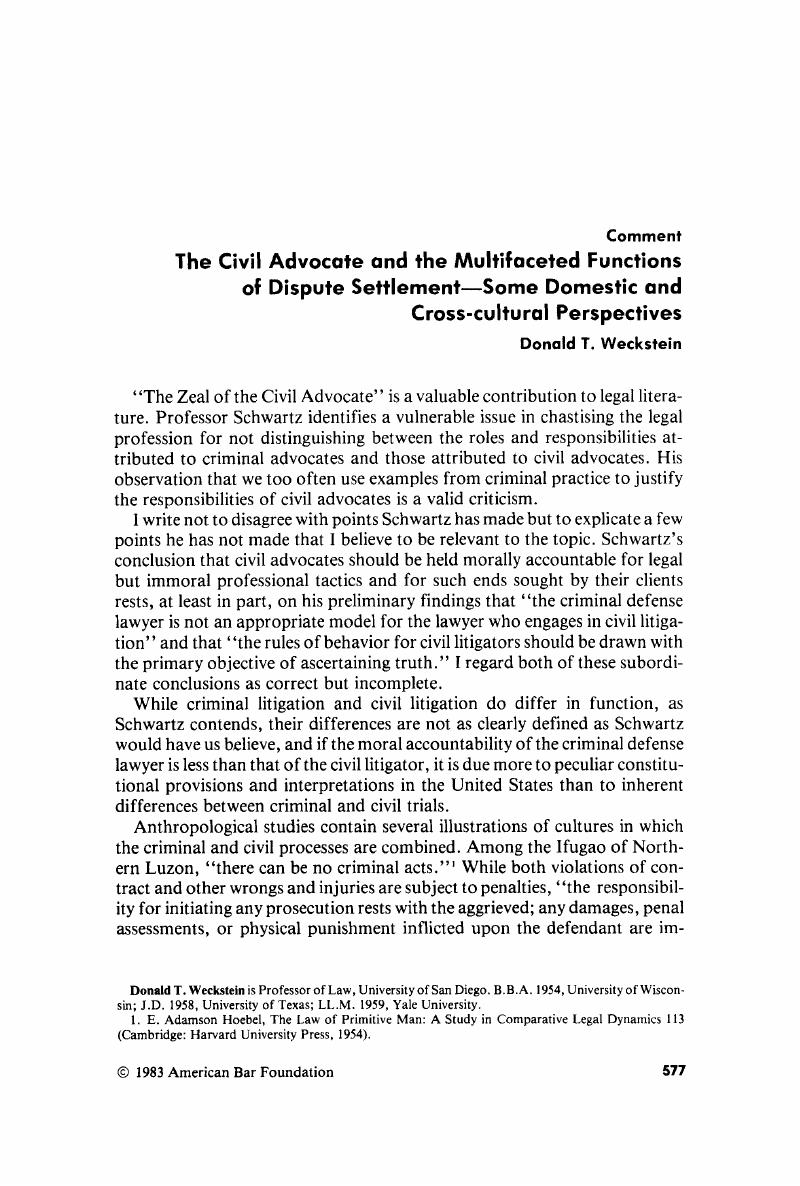Published online by Cambridge University Press: 20 November 2018

1 E. Adamson Hoebel, The Law of Primitive Man: A Study in Comparative Legal Dynamics 113 (Cambridge: Harvard University Press, 1954).Google Scholar
2 Id. at 113-14.Google Scholar
3 Id. at 218, 245Google Scholar
4 Id. at 245.Google Scholar
5 Id. at 216-18.Google Scholar
6 Id. at 245-46.Google Scholar
7 Id. at 234.Google Scholar
8 Id. at 28. See also id. at 52–53, 87–90, 113–20, 135–36, 139–40, 310–11, 315–16, 318–19, 329–30; Simon Roberts, Order and Dispute: An Introduction to Legal Anthropology 57–58, 92, 116–18 (New York: St. Martin's Press, 1979); Vivian J. Rohrl, Compensation in Cross-cultural Perspective, in Donald Black, ed., 1 Toward a General Theory of Social Control ch. 7 (New York: Academic Press, 1983).Google Scholar
9 See generally Hoebel, supra note 1; Roberts, supra note 8, at 38, 53–79, 88–90, 93–94, 116–25, 154–67.Google Scholar
10 Thurman W. Arnold, The Symbols of Government 129 (New Haven, Conn.: Yale University Press, 1935).Google Scholar
11 Id. at 130.Google Scholar
12 This type of assertion, it is often noted, needs no authority to support it. I invoke the equivalent by citing myself See Robert H. Aronson & Donald T. Weckstein, Professional Responsibility in a Nutshell 265–73 (St. Paul, Minn.: West Publishing Co., 1980), which suggests an analysis similar to that contained herein.Google Scholar
13 Even if the facts found in a particular trial are subsequently learned to be erroneous, the system of precedent is not corrupted since the “rule of that case” is limited by the facts found, stated, or assumed in that decision regardless of what the “true” facts may have been. Thus, ethical codes treat the duty to disclose adverse facts in a different way than the duty to disclose adverse law—failure to disclose adverse law can wrongfully infect a legal ruling and precedent. See, e.g., ABA's Model Code of Professional Responsibility DR 7-106(B)(l), EC 7-23, 7-27 (Aug. 1980); Model Rules of Professional Conduct Rule 3.3,3.4 (adopted Aug. 2, 1983), which require disclosure of adverse law in the controlling jurisdiction, but as to adverse facts require only that an advocate not conceal or secrete, allowing that he or she not reveal unless otherwise required by law and if the information is not privileged.Google Scholar
14 Thus justifying the distinction made in the familiar anecdote concerning Samuel Williston's not disclosing evidence that was contrary to a favorable fact-finding made by a judge in a civil matter. See Charles P. Curtis, It's Your Law 17 (Cambridge: Harvard University Press, 1954).Google Scholar
15 Fuller, Lon L., The Forms and Limits of Adjudication, 92 Haw. L. Rev. 353, 364, 382–85 (1978). The latter pages incorporate a portion of the report coauthored by Fuller and John D. Randall, Professional Responsibility: Report of the Joint Conference, 44 A.B.A. J. 1159 (1958).Google Scholar
16 See Summers, Robert S., Evaluating and Improving 1.egal Processes—A Plea for “Process Values,” M) Cornell L. Rev. 1 (1974).Google Scholar
17 See Fried, Charles, The Lawyer as Friend: The Moral Foundations of the Lawyer-Client Relation, 85 Yale L.J. 1060 (1976).Google Scholar
18 See Thode, E. Wayne, The Ethical Standard for the Advocate, 39 Tex. L. Rev. 575 (1961).Google Scholar
19 See ABA's Model Rules of Professional Conduct 1.6, 1.13, 3.3, and comments and legal background notes relating thereto (adopted Aug. 2, 1983).Google Scholar
20 Id. at Rule 1.6.Google Scholar